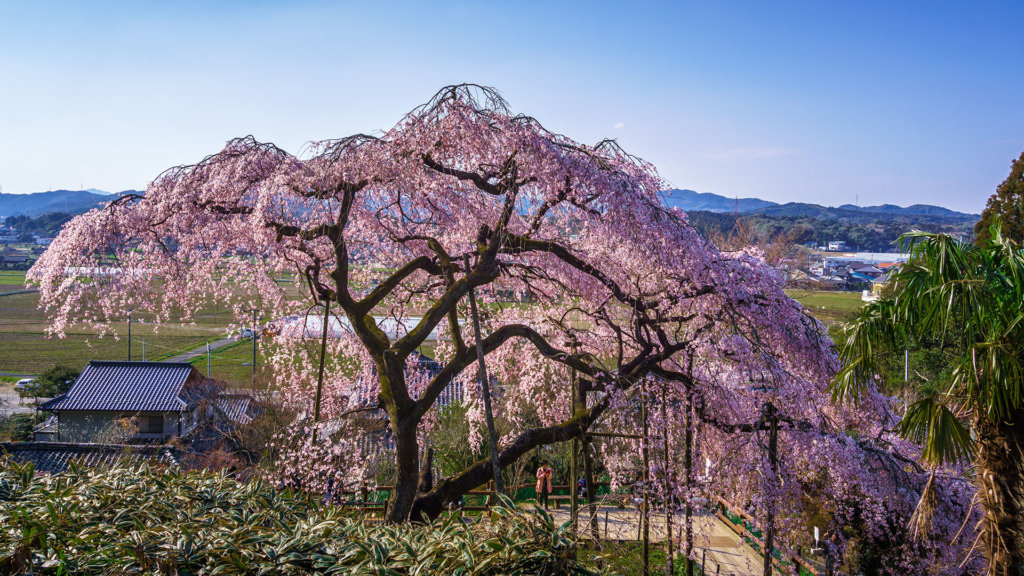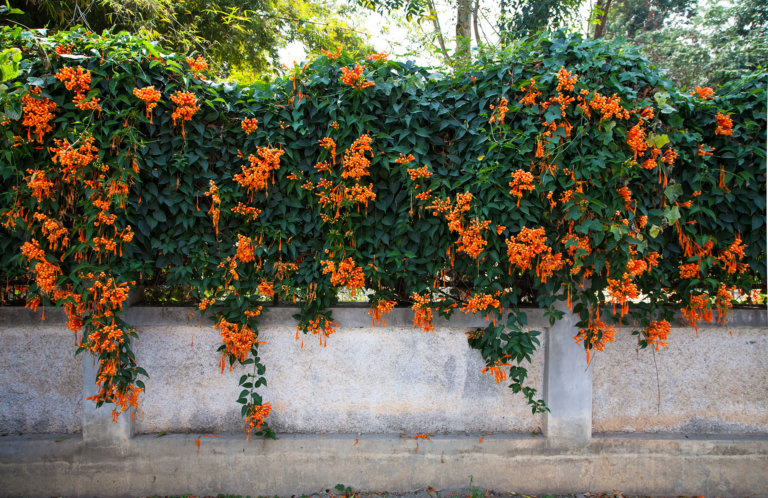Weeping trees have a distinctive, elegant look that works in all types of landscapes and gardens. Their branches arch up briefly before cascading down towards the ground. This graceful growth pattern makes weeping trees a focal point no matter where they’re planted.
A few weeping trees come directly from nature. However, many of today’s most elegant examples result from grafting weeping branches to a standard trunk. The trunk provides the sturdy base for the cascading branches to root and take hold. Once they’re in place, they can grow up and over, giving the tree it’s beautiful profile.
Let’s look at 12 of the most elegant weeping trees for your garden.
#1: Weeping Willow
In North America, the weeping willow is the iconic cascading tree in many areas. Its slender branches can arch over to reach the ground. It can reach up to 50 feet tall and 50 feet wide under the right conditions.
In nature, you can find this tree along river banks and lakes. It loves rich, wet soil that drains well. The willow needs full sun but should be sheltered from high winds due to its delicate branches. It grows in USDA zones 4 to 9a.
Do not plant near buildings as the roots can infiltrate the pipes and disturb the foundation.
#2: Weeping Japanese Maple
If you want to bring a bit of Oriental beauty to your landscape, the weeping Japanese maple is the perfect specimen. It’s a common cultivar for bonsai gardens but has made its presence known in gardens around the world.
The leaves of the weeping Japanese maple come in a range of colors, including reds, oranges, purples, and yellows. Depending on the variety, this tree can grow from 10 to 25 feet tall and up to 25 feet wide.
You can select from multiple varieties, including ‘Green Cascade’ and ‘Matsukaze.’ It can grow in USDA zones 5 to 9, depending on which variety you choose. This tree can tolerate part shade to full sun. You do need rich, acidic soil that’s moist but well-drained.
#3: Weeping Fig
The weeping fig loves the heat, thriving in places like South Florida and Hawaii. It requires USDA growing zones 10 or 11. In these hot zones, the weeping fig can actually grow up to 100 feet tall.
This tree actually does well as an indoor plant, as long as it receives sufficient water. It thrives in both full sun and full shade. To keep the leaves from shedding, experts recommend keeping the plant in the same location. It can be pruned to between three and six-feet tall.
The weeping fig loves well-drained soil that is medium to dry with moisture. When the plant gets stressed, it can shed leaves.
#4: Inversa Norway Spruce
For a truly unique look that will capture the eye, the Inversa Norway Spruce is a spectacular option. If left on its own, this tree will grow as a ground cover. To get it to grow vertically, the gardener trains it up a central support.
The final result is stunning. Graceful evergreen branches swoop down from this tree in all directions. It’s also extremely cold tolerant and one of the hardiest weeping varieties. It keeps its needles all-year-round, offering a focal point in the middle of winter.
The Inversa Norway Spruce grows well in USDA zones 3 to 8. It can thrive in full sun or part shade. It likes acidic soil that’s well-drained, rich, and a bit sandy.
#5: Golden Curls Willow
The Golden Curls willow goes by many names, including the curly willow, the globe willow, and the Dragon’s Claw. Its curling branches and leaves bring focal interest year-round.
Once thought to be a variety of weeping willow, the Golden Curls is actually a separate species. It loves moist, well-drained soil. If left to its own devices, this tree can grow up to 30 feet tall and 15 feet wide.
It’s best to prune it back in the early spring to give this tree form and to remove any loose branches. It grows in USDA zones 5 to 9 and loves full sun or partial shade.
#6: Weeping Birch
The white or light-colored bark of the weeping birch makes it a favorite in many gardens. Branches arch out in different directions, creating a broad canopy of leaves. The branches reach down towards the ground but don’t quite reach it.
Gardeners have created multiple varieties of the weeping birch, each with its own unique features. The ‘Purpurea’ variety, for example, has purple leaves instead of the more common green ones.
This tree can stand between 30 and 100 feet tall, depending on the variety grown. It can grow in zones from 2 to 9, again depending on the cultivar. It loves full sun to part shade. This tree needs a deep soil base that’s well-drained but rich in nutrients.
#7: Weeping Flowering Cherry
The brilliant pink flowers of the flowering cherry are a sure sign that spring has arrived. The weeping flowering cherry originates from Japan. It’s a grafted variety that has a standard cherry tree base and branches from weeping varieties.
This tree lives a long time, with some cultivars living hundreds of years. It can live in many locations as long as they get plenty of sunlight. It likes soil that’s moist but not too wet.
The weeping flowering cherry can thrive in USDA zones from 5 to 8. It can grow up to 20 feet high and 20 feet wide. This tree grows fast and should be kept away from buildings of all sorts.
#8: Nootka Cypress
Despite its name and appearance, the Nootka cypress is actually a true conifer. It’s often called the yellow cypress or the yellow cedar due to the yellow cast to its foliage. It can live over 1000 years in the wild.
Most specimens found in gardens today are cultivars designed for today’s landscapes. They grow into a pyramidal shape, with a nodding leader that adds additional movement and grace to the adult plant.
The Nootka cypress often grows up to 30 feet tall and 12 feet wide. It likes full sun but can do well in partial shade. It needs moist, well-drained soil that has plenty of nutrients. This tree thrives in USDA zones 4 to 7.
#9: Weeping Juniper
The weeping juniper brings blue-tinted evergreen needles on gracefully cascading branches. This juniper originates in the Rocky Mountains and is completely native to North America.
One of the outstanding features of this tree is its hardiness. It does well in drought and heat while being able to take harsh winters as well. It thrives in USDA zones from 4 to 7.
The ideal growing environment for the weeping juniper is in full sun with well-drained soil. It needs sufficient moisture but can go dry with minimal problems. It can grow up to 20 feet tall and up to 10 feet wide.
#10: Weeping Purple Beech
If you want a tree that brings color and style to any garden, the weeping purple beech is an ideal specimen. Originating from Europe, it brings bold purple-black leaves in the first breath of spring. As summer and fall arrive, the leaves turn a coppery bronze, making it an ideal focal point throughout the growing seasons.
Its tall, slender profile makes it an optimal addition to many landscapes. This tree can reach 30 feet tall at full height but only gets to 15 feet wide. It grows very slowly.
The weeping purple beech thrives in USDA zones 5 to 7. It needs full sun but can grow in partial shade. It likes moist, well-drained soil.
#11: Weeping Mulberry
If you’re looking for a smaller weeping tree, the weeping mulberry is one to consider. It grows to 10 feet wide and 12 feet wide when fully mature, but can be pruned to maintain a lower height.
This tree is very easy to grow, making it a favorite for the casual home gardener. It has shiny green leaves, with branches that can reach down to the ground. It likes full sun and well-drained soil.
Another great feature of the weeping mulberry is that it’s very drought tolerant. It grows well in USDA zones 4 to 8. However, it can become invasive in some environments. You should consult local experts on the best way to manage this tree.
#12: Weeping Crabapple
Spring color is a given when you add the weeping crabapple to your landscape. This tree comes in many varieties, with different colored flowers and autumn foliage. The common cultivar, ‘Louisa,’ for example, has soft pink flowers and golden leaves during the fall.
It can grow up to 15 feet tall and 15 feet wide, making it a good specimen for many landscapes. Most varieties favor full sun with well-drained yet moist soils.
The weeping crabapple thrives in USDA zones from 4 to 8. It’s low-maintenance and a favorite among amateur gardeners. It can take heavy pruning to obtain an umbrella-like shape.







